ion
-
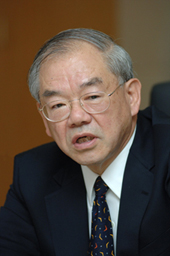 KAIST President Suh Honored with 2009 ASME Medal
KAIST President Nam-Pyo Suh has chosen as the 2009 winner of the ASME Medal presented by the American Society of Mechanical Engineers, university authorities said on Thursday (July 2).
President Suh received the honor for "seminal contributions to the advancement of engineering through research in tribology, polymer processing, metal processing, design and manufacturing, as well as contributions to engineering education and research infrastructure."
The selection of President Suh was unanimously approved by the 13-member Board of Governors of the ASME. Suh became the first scientist of Asian descent in the award"s 89-year-long history.
Founded in 1880, the ASME is a non-profit professional organization promoting the art, science and practice of mechanical and multidisciplinary engineering and allied sciences. The organization is known for setting codes and standards for mechanical devices. As of 2009, it has 120,000 members worldwide.
Only one ASME medal is awarded annually to recognize "eminently distinguished achievement." The award consists of a $17,000 honorarium, a gold medal, certificate and travel supplement for two days. It will be presented to President Suh during the 2009 International Mechanical Engineering Congress and Exposition, which will be held in Lake Buena Vista, Florida, November 13-10, 2009.
President Suh is an internationally known educator, engineer and inventor. Born in Korea, he immigrated to the U.S. in 1954 to join his father, who was teaching at Harvard. He earned both his bachelor"s and master"s degrees from MIT before coming to Carnegie Tech for his doctoral education in mechanical engineering.
While teaching at MIT, he founded the MIT-Industry Polymer Processing Program in 1973 and the Laboratory for Manufacturing and Productivity. He left these positions in 1984 to serve with the U.S. National Science Foundation as its assistant director for engineering, until 1988.
He invented many new materials, products and manufacturing processes, earning more than 60 U. S. patents and founding several companies. He has written seven books and more than 300 scholarly papers. Among dozens of honors throughout his career, President Suh most recently received the 2007 Lifetime Achievement from the Society of Plastics Engineers.
The ASME conducts one of the world"s largest technical publishing operations through its ASME Press, holds numerous technical conferences and hundreds of professional development courses each year, and sponsors numerous outreach and educational programs.
2009.07.02 View 15620
KAIST President Suh Honored with 2009 ASME Medal
KAIST President Nam-Pyo Suh has chosen as the 2009 winner of the ASME Medal presented by the American Society of Mechanical Engineers, university authorities said on Thursday (July 2).
President Suh received the honor for "seminal contributions to the advancement of engineering through research in tribology, polymer processing, metal processing, design and manufacturing, as well as contributions to engineering education and research infrastructure."
The selection of President Suh was unanimously approved by the 13-member Board of Governors of the ASME. Suh became the first scientist of Asian descent in the award"s 89-year-long history.
Founded in 1880, the ASME is a non-profit professional organization promoting the art, science and practice of mechanical and multidisciplinary engineering and allied sciences. The organization is known for setting codes and standards for mechanical devices. As of 2009, it has 120,000 members worldwide.
Only one ASME medal is awarded annually to recognize "eminently distinguished achievement." The award consists of a $17,000 honorarium, a gold medal, certificate and travel supplement for two days. It will be presented to President Suh during the 2009 International Mechanical Engineering Congress and Exposition, which will be held in Lake Buena Vista, Florida, November 13-10, 2009.
President Suh is an internationally known educator, engineer and inventor. Born in Korea, he immigrated to the U.S. in 1954 to join his father, who was teaching at Harvard. He earned both his bachelor"s and master"s degrees from MIT before coming to Carnegie Tech for his doctoral education in mechanical engineering.
While teaching at MIT, he founded the MIT-Industry Polymer Processing Program in 1973 and the Laboratory for Manufacturing and Productivity. He left these positions in 1984 to serve with the U.S. National Science Foundation as its assistant director for engineering, until 1988.
He invented many new materials, products and manufacturing processes, earning more than 60 U. S. patents and founding several companies. He has written seven books and more than 300 scholarly papers. Among dozens of honors throughout his career, President Suh most recently received the 2007 Lifetime Achievement from the Society of Plastics Engineers.
The ASME conducts one of the world"s largest technical publishing operations through its ASME Press, holds numerous technical conferences and hundreds of professional development courses each year, and sponsors numerous outreach and educational programs.
2009.07.02 View 15620 -
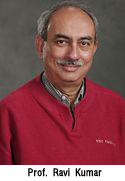 USC Professor Appointed New Dean of KAIST College of Business
Ravi Kumar, former vice dean of the Graduate and International Program at the University of Southern California, has been appointed as dean of the KAIST College of Business, the university announced on Tuesday (June 30).
Dr. Kumar has been a professor of information and operations management at the Marshall School of Business, USC. He is widely known for his research on global operations, particularly in improving operational performance through cellular design and integrated decision-making with marketing and information technology.
KAIST President Nam-Pyo Suh said: "We are fortunate to have Prof. Kumar as the new Dean of the College of Business. He has made many important contributions to the USC business school, especially in adding international dimensions to the school"s activities. He has established an impeccable reputation as a scholar and visionary. We expect that he will display great leadership in making the KAIST College of Business one of the best schools of its kind in the world."
Prof. Kumar received his bachelor degree from the Indian Institute of Technology in 1974, master degree from the University of Texas, Arlington, in 1976 and doctorate degree from Northwestern University in 1981.
His papers have been published in Management Science, Marketing Science, Journal of Economic Theory, Production and Operations Management, Journal of Operations Management and Journal of Management Information Systems. He serves as a senior editor on the Board of Production and Operations management and Operations management Educational Review.
He has won several awards for teaching excellence at both the University of Illinois Urbana-Champaign and USC. They included the Outstanding Educator Award and the Golden Apple Teaching Award.
Prof. Kumar has extensive international consulting experiences with Rolls Royce, BMW, Daimler Benz Aerospace, ABB, Ericsson, BAS Global, Motorola, Reuters, Du Pont, Sanwa Bank, Korea First Bank, Korean Air, Infosys, Acer, Shell Hong Kong and other companies.
2009.07.01 View 15629
USC Professor Appointed New Dean of KAIST College of Business
Ravi Kumar, former vice dean of the Graduate and International Program at the University of Southern California, has been appointed as dean of the KAIST College of Business, the university announced on Tuesday (June 30).
Dr. Kumar has been a professor of information and operations management at the Marshall School of Business, USC. He is widely known for his research on global operations, particularly in improving operational performance through cellular design and integrated decision-making with marketing and information technology.
KAIST President Nam-Pyo Suh said: "We are fortunate to have Prof. Kumar as the new Dean of the College of Business. He has made many important contributions to the USC business school, especially in adding international dimensions to the school"s activities. He has established an impeccable reputation as a scholar and visionary. We expect that he will display great leadership in making the KAIST College of Business one of the best schools of its kind in the world."
Prof. Kumar received his bachelor degree from the Indian Institute of Technology in 1974, master degree from the University of Texas, Arlington, in 1976 and doctorate degree from Northwestern University in 1981.
His papers have been published in Management Science, Marketing Science, Journal of Economic Theory, Production and Operations Management, Journal of Operations Management and Journal of Management Information Systems. He serves as a senior editor on the Board of Production and Operations management and Operations management Educational Review.
He has won several awards for teaching excellence at both the University of Illinois Urbana-Champaign and USC. They included the Outstanding Educator Award and the Golden Apple Teaching Award.
Prof. Kumar has extensive international consulting experiences with Rolls Royce, BMW, Daimler Benz Aerospace, ABB, Ericsson, BAS Global, Motorola, Reuters, Du Pont, Sanwa Bank, Korea First Bank, Korean Air, Infosys, Acer, Shell Hong Kong and other companies.
2009.07.01 View 15629 -
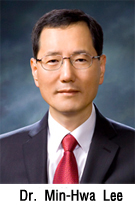 Lecture Hall Named After Venture Businessman Min-Hwa Lee
A lecture hall in the Alumni Start-Up Building on the KAIST campus was named Min-Hwa Lee Hall in a ceremony on Tuesday to pay tribute to KAIST alumnus Min-Hwa Lee"s contributions to the development of Korean venture business.
On hand at the ceremony were Sung-Woo Hong, head of the Small and Medium Business Administration, KAIST President Nam-Pyo Suh, dozens of KAIST alumni representatives, and figures from government research institutes.
Lee, who obtained his M.S. (1978) and Ph.D. (1985) in Electrical Engineering from KAIST, established a fund of 10 billion won along with other KAIST alumni in 2001 and donated it for the construction of the Alumni Start-Up Building for aspiring entrepreneurs. To remember his lofty vision, KAIST decided to name a lecture hall after him.
As a venture businessman, Lee founded the Madison, Ltd., one of the earliest venture companies in Korea, in 1985. Lee then played a leading role in the creation of the Korea Venture Industry Association in 1995, and in the establishment of KOSDAQ and the enactment of a special law for venture enterprises.
KAIST will appoint Lee as an adjunct professor in recognition of his expertise in venture business and commercialization of new inventions. Lee will teach entrepreneurship at the Graduate School of Management and the Institute for Gifted Students, a KAIST affiliate.
"Dr. Lee has made a great contribution to the development of Korean venture business. At a time when commercialization of new inventions was at an infant stage, he nurtured technology ventures and built the foundation for the proliferation of technology venture," President Suh said. "We expect that he will strive to open the generation of technologies which will lead the development of Korea in the future and become a mentor of aspiring entrepreneurs," Suh added.
2009.06.30 View 17921
Lecture Hall Named After Venture Businessman Min-Hwa Lee
A lecture hall in the Alumni Start-Up Building on the KAIST campus was named Min-Hwa Lee Hall in a ceremony on Tuesday to pay tribute to KAIST alumnus Min-Hwa Lee"s contributions to the development of Korean venture business.
On hand at the ceremony were Sung-Woo Hong, head of the Small and Medium Business Administration, KAIST President Nam-Pyo Suh, dozens of KAIST alumni representatives, and figures from government research institutes.
Lee, who obtained his M.S. (1978) and Ph.D. (1985) in Electrical Engineering from KAIST, established a fund of 10 billion won along with other KAIST alumni in 2001 and donated it for the construction of the Alumni Start-Up Building for aspiring entrepreneurs. To remember his lofty vision, KAIST decided to name a lecture hall after him.
As a venture businessman, Lee founded the Madison, Ltd., one of the earliest venture companies in Korea, in 1985. Lee then played a leading role in the creation of the Korea Venture Industry Association in 1995, and in the establishment of KOSDAQ and the enactment of a special law for venture enterprises.
KAIST will appoint Lee as an adjunct professor in recognition of his expertise in venture business and commercialization of new inventions. Lee will teach entrepreneurship at the Graduate School of Management and the Institute for Gifted Students, a KAIST affiliate.
"Dr. Lee has made a great contribution to the development of Korean venture business. At a time when commercialization of new inventions was at an infant stage, he nurtured technology ventures and built the foundation for the proliferation of technology venture," President Suh said. "We expect that he will strive to open the generation of technologies which will lead the development of Korea in the future and become a mentor of aspiring entrepreneurs," Suh added.
2009.06.30 View 17921 -
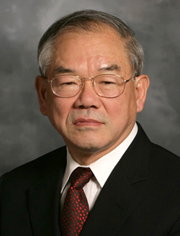 President Suh Speaks on Innovation in Asia at Glion Colloquium
KAIST President Nam-Pyo Suh stressed the importance of innovation in economic advancement in an address he delivered at the Glion Colloquium held in Glion, Switzerland, university authorities said on Wednesday (June 24).
In the speech, entitled "On Innovation Strategies: An Asian Perspective," President Suh said that for Asian countries such as China, Japan, Korea and Taiwan to continue to compete in the global economy, they must become innovators.
Over the past decade the Glion Colloquium organized by the University of Geneva has established itself as an influential international forum on higher education issues, related to research intensive universities in particular.
When it was launched in 1998, the Glion Colloquium immediately drew worldwide attention with “The Glion Declaration: the University at the Millennium,” prepared for the 1998 Paris UNESCO World Conference on Higher Education in the 21st Century.
Every two years, the colloquium brings together in Glion, Switzerland, leaders from renowned universities and higher education organizations, along with influential business and government figures, from North America, Europe and other parts of the world.
2009.06.25 View 11990
President Suh Speaks on Innovation in Asia at Glion Colloquium
KAIST President Nam-Pyo Suh stressed the importance of innovation in economic advancement in an address he delivered at the Glion Colloquium held in Glion, Switzerland, university authorities said on Wednesday (June 24).
In the speech, entitled "On Innovation Strategies: An Asian Perspective," President Suh said that for Asian countries such as China, Japan, Korea and Taiwan to continue to compete in the global economy, they must become innovators.
Over the past decade the Glion Colloquium organized by the University of Geneva has established itself as an influential international forum on higher education issues, related to research intensive universities in particular.
When it was launched in 1998, the Glion Colloquium immediately drew worldwide attention with “The Glion Declaration: the University at the Millennium,” prepared for the 1998 Paris UNESCO World Conference on Higher Education in the 21st Century.
Every two years, the colloquium brings together in Glion, Switzerland, leaders from renowned universities and higher education organizations, along with influential business and government figures, from North America, Europe and other parts of the world.
2009.06.25 View 11990 -
 KAIST to hold International Workshop on Flexible Displays
The 2009 KAIST International Workshop on Flexible Displays will take place at the Electrical Engineering Building on June 25, university sources said on Tuesday (June 23).
The workshop organized by the Center for Advanced Flexible Display Convergence (CAFDC) will explore the status and future vision of flexible and transparent plasma displays, which are among the key technologies for the development of the next-generation displays. There will be also discussions about technologies to realize the large-scale flexible and transparent display which is regarded as the display of the future.
Among the speakers are some of the most prominent figures in the field. Gary Eden from University of Illinois, Prof. Kunihide Tachibana from Kyoto University, and Carol Wedding, the president of Imaging Systems Tech., USA and several other well-known professors and engineers will participate in the workshop.
Professor Kyung-Cheol Choi, CAFDC chair, said: "The workshop will provide an excellent opportunity to examine the flexible and transparent plasma display technologies. It will also be a good chance to explore large-scale flexible and transparent displays from various technical viewpoints."
2009.06.24 View 21124
KAIST to hold International Workshop on Flexible Displays
The 2009 KAIST International Workshop on Flexible Displays will take place at the Electrical Engineering Building on June 25, university sources said on Tuesday (June 23).
The workshop organized by the Center for Advanced Flexible Display Convergence (CAFDC) will explore the status and future vision of flexible and transparent plasma displays, which are among the key technologies for the development of the next-generation displays. There will be also discussions about technologies to realize the large-scale flexible and transparent display which is regarded as the display of the future.
Among the speakers are some of the most prominent figures in the field. Gary Eden from University of Illinois, Prof. Kunihide Tachibana from Kyoto University, and Carol Wedding, the president of Imaging Systems Tech., USA and several other well-known professors and engineers will participate in the workshop.
Professor Kyung-Cheol Choi, CAFDC chair, said: "The workshop will provide an excellent opportunity to examine the flexible and transparent plasma display technologies. It will also be a good chance to explore large-scale flexible and transparent displays from various technical viewpoints."
2009.06.24 View 21124 -
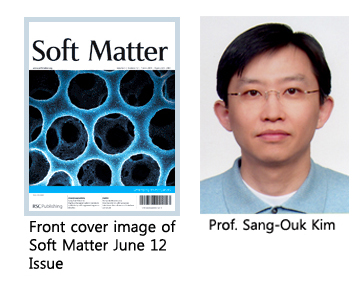 Prof. Sang-Ouk Kim Featured on the Cover of Emerging Investigator Special Issue
KAIST Prof. Sang-Ouk Kim of the Department of Materials Science and Engineering was featured on the cover of the Emerging Investigator Special Issue published by Britain"s Royal Society of Chemistry on June 21, university authorities said on Monday (June 22).
The special issue shed spotlight on 18 up-and-coming scientists who have been selected through the recommendation and rigorous screening process of the editorial and advisory boards of the Royal Society of Chemistry. The 18 scientists consist of six from the American continent, 10 from Europe, one from Japan and one from Korea.
The journal introduced Prof. Kim"s paper, titled "Highly entangled carbon nanotube (CNT) scaffolds by self-organized aqueous droplets." Kim explained in the paper that the cellular CNT demonstrated high electrical conductivity and field-emission properties, which is potentially useful for various applications in electronics and energy storage devices.
2009.06.24 View 15201
Prof. Sang-Ouk Kim Featured on the Cover of Emerging Investigator Special Issue
KAIST Prof. Sang-Ouk Kim of the Department of Materials Science and Engineering was featured on the cover of the Emerging Investigator Special Issue published by Britain"s Royal Society of Chemistry on June 21, university authorities said on Monday (June 22).
The special issue shed spotlight on 18 up-and-coming scientists who have been selected through the recommendation and rigorous screening process of the editorial and advisory boards of the Royal Society of Chemistry. The 18 scientists consist of six from the American continent, 10 from Europe, one from Japan and one from Korea.
The journal introduced Prof. Kim"s paper, titled "Highly entangled carbon nanotube (CNT) scaffolds by self-organized aqueous droplets." Kim explained in the paper that the cellular CNT demonstrated high electrical conductivity and field-emission properties, which is potentially useful for various applications in electronics and energy storage devices.
2009.06.24 View 15201 -
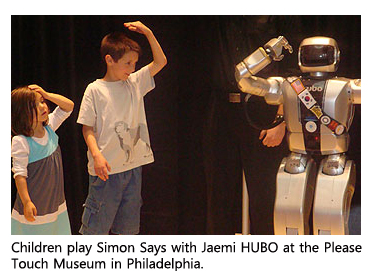 U.S. and Korean Researchers Unveil Newest Research Team Member: Jaemi the Humanoid
- Project aims to enable humanoids to interact with people and their environment
June 1, 2009-- A Drexel University-led research team late last week unveiled the newest, most central member of its collaboration with a team of Korean researchers: Jaemi, a humanoid (HUBO). Jaemi HUBO embodies efforts to advance humanoid development and enhance the concept of human-robotic interaction. The project"s goal is to enable humanoids to interact with their environment, and enhancement plans include enabling the humanoid to move over rugged terrain, in unstructured environments and to interact socially with humans and handle objects.
The five-year project, funded through the National Science Foundation (NSF) Partnership for International Research and Education (PIRE) program, seeks transformative models to catalyze discovery through international research collaboration and train U.S. students and junior researchers to effectively think and work in global teams.
"The field of robotics is among the top 10 technology areas considered engines for economic growth. Korea understands this and is aggressively pursuing robotics. To stay competitive, the U.S. must do the same," said Mark Suskin, acting deputy director of NSF"s Office of International Science and Engineering. "NSF"s PIRE program and this robotics collaboration in particular, enable the U.S. to capitalize on research in other countries and remain competitive."
The PIRE research team is composed of researchers at The University of Pennsylvania, Colby College, Bryn Mawr College and Virginia Tech in the United States; and Korea Advanced Institute of Science and Technology (KAIST), Korea University and Seoul National University in Korea.
The team obtained a version of KAIST"s HUBO humanoid, which it named Jaemi HUBO and decided to house it at Drexel University. KAIST HUBO lab has become a model of cutting advance humanoid research by relatively small teams working on tight budgets.
KAIST excels in humanoid leg and body design, biped gait (walking, running, kicking), balance (modeling and control system design), and hardware integration. U.S. robotics researchers tend to enjoy an edge in locomotion over rugged, unstructured terrain; manipulation/grasping; cognition, perception and human-robot interaction; and vision (image, understanding, navigation).
This collaboration of American and Korean researchers will seek to draw on the expertise of each researcher and take Jaemi HUBO to the next level of development--that is, to improve Jaemi"s capabilities to navigate and manipulate objects and interact with people in unstructured environments. Such capabilities demand information technologies like cognition, perception and networking areas. Targeted enhancement features include a capability to move over rugged terrain and in unstructured environments and to handle objects and interact socially with humans.
Jaemi HUBO will also educate the American public, particularly young people, about the science of robotics. This education process began at the Please Touch Museum in Philadelphia on May 28, 2009, when Jaemi HUBO was unveiled and introduced to a crowded audience of children and a few adults. Neither male nor female,Jaemi connected with the children, boys and girls alike. Guided by a Drexel University graduate student, Jamei moved, spoke, danced, shook hands and lead the children in a game of Simon Says. Such access to Jaemi HUBO starkly contrasts with that afforded by other high-profile humanoids that are often protected trade secrets, largely inaccessible to the public.
Museum curators are pleased to have had Jaemi visit and entertain kids during the weekend. "At the Please Touch Museum, we promote learning through a variety of senses," said J. Willard Whitson,the museum"s vice president for exhibits and education. "A humanoid not only embodies our goal of building layers of knowledge in young people, but Jaemi helps all of us celebrate the playful side of technology."
Jaemi HUBO is now at its permanent home at Drexel University, from which travel and guest appearances may be arranged by appointment. Journalists interested in meeting and interviewing Jaemi HUBO and other research team members are encouraged to contact Lisa-Joy Zgorski at lisajoy@nsf.gov. (Press Release of U.S. National Science Foundation)
2009.06.19 View 17111
U.S. and Korean Researchers Unveil Newest Research Team Member: Jaemi the Humanoid
- Project aims to enable humanoids to interact with people and their environment
June 1, 2009-- A Drexel University-led research team late last week unveiled the newest, most central member of its collaboration with a team of Korean researchers: Jaemi, a humanoid (HUBO). Jaemi HUBO embodies efforts to advance humanoid development and enhance the concept of human-robotic interaction. The project"s goal is to enable humanoids to interact with their environment, and enhancement plans include enabling the humanoid to move over rugged terrain, in unstructured environments and to interact socially with humans and handle objects.
The five-year project, funded through the National Science Foundation (NSF) Partnership for International Research and Education (PIRE) program, seeks transformative models to catalyze discovery through international research collaboration and train U.S. students and junior researchers to effectively think and work in global teams.
"The field of robotics is among the top 10 technology areas considered engines for economic growth. Korea understands this and is aggressively pursuing robotics. To stay competitive, the U.S. must do the same," said Mark Suskin, acting deputy director of NSF"s Office of International Science and Engineering. "NSF"s PIRE program and this robotics collaboration in particular, enable the U.S. to capitalize on research in other countries and remain competitive."
The PIRE research team is composed of researchers at The University of Pennsylvania, Colby College, Bryn Mawr College and Virginia Tech in the United States; and Korea Advanced Institute of Science and Technology (KAIST), Korea University and Seoul National University in Korea.
The team obtained a version of KAIST"s HUBO humanoid, which it named Jaemi HUBO and decided to house it at Drexel University. KAIST HUBO lab has become a model of cutting advance humanoid research by relatively small teams working on tight budgets.
KAIST excels in humanoid leg and body design, biped gait (walking, running, kicking), balance (modeling and control system design), and hardware integration. U.S. robotics researchers tend to enjoy an edge in locomotion over rugged, unstructured terrain; manipulation/grasping; cognition, perception and human-robot interaction; and vision (image, understanding, navigation).
This collaboration of American and Korean researchers will seek to draw on the expertise of each researcher and take Jaemi HUBO to the next level of development--that is, to improve Jaemi"s capabilities to navigate and manipulate objects and interact with people in unstructured environments. Such capabilities demand information technologies like cognition, perception and networking areas. Targeted enhancement features include a capability to move over rugged terrain and in unstructured environments and to handle objects and interact socially with humans.
Jaemi HUBO will also educate the American public, particularly young people, about the science of robotics. This education process began at the Please Touch Museum in Philadelphia on May 28, 2009, when Jaemi HUBO was unveiled and introduced to a crowded audience of children and a few adults. Neither male nor female,Jaemi connected with the children, boys and girls alike. Guided by a Drexel University graduate student, Jamei moved, spoke, danced, shook hands and lead the children in a game of Simon Says. Such access to Jaemi HUBO starkly contrasts with that afforded by other high-profile humanoids that are often protected trade secrets, largely inaccessible to the public.
Museum curators are pleased to have had Jaemi visit and entertain kids during the weekend. "At the Please Touch Museum, we promote learning through a variety of senses," said J. Willard Whitson,the museum"s vice president for exhibits and education. "A humanoid not only embodies our goal of building layers of knowledge in young people, but Jaemi helps all of us celebrate the playful side of technology."
Jaemi HUBO is now at its permanent home at Drexel University, from which travel and guest appearances may be arranged by appointment. Journalists interested in meeting and interviewing Jaemi HUBO and other research team members are encouraged to contact Lisa-Joy Zgorski at lisajoy@nsf.gov. (Press Release of U.S. National Science Foundation)
2009.06.19 View 17111 -
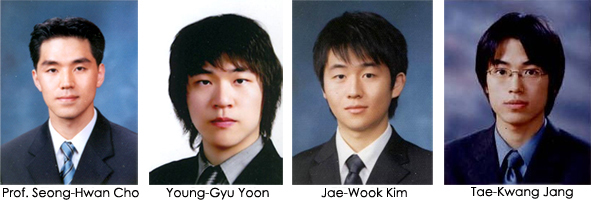 Prof. Cho's Team Awarded Best Paper Prize by IEEE
A team led by Prof. Seong-Hwan Cho of the School of Electrical Engineering and Computer Science, KAIST, won the 2009 Guillemin-Cauer Best Paper Award for their paper published in the IEEE Transactions on Circuits and Systems Journal last May, university authorities said on Thursday (June 4).
The team"s paper was entitled "A Time-based Bandpass ADC Using Time-Interleaved Voltage-Controlled Oscillators." The prize is given to a paper regarded as the best among about 350 papers published in the prestigious journal in the circuit theory area. Co-recipients of the award are Young-Gyu Yoon, Jae-Wook Kim and Tae-Kwang Jang. The award was presented at the annual 2009 International Symposium for Circuits and Systems in Taipei, Taiwan, on May 26.
The Institute of Electrical and Electronics Engineers or IEEE is an international non-profit, professional organization for the advancement of technology related to electricity. The New York-based organization has more than 365,000 members in about 150 countries making it the largest technical professional organization in the world.
2009.06.05 View 16046
Prof. Cho's Team Awarded Best Paper Prize by IEEE
A team led by Prof. Seong-Hwan Cho of the School of Electrical Engineering and Computer Science, KAIST, won the 2009 Guillemin-Cauer Best Paper Award for their paper published in the IEEE Transactions on Circuits and Systems Journal last May, university authorities said on Thursday (June 4).
The team"s paper was entitled "A Time-based Bandpass ADC Using Time-Interleaved Voltage-Controlled Oscillators." The prize is given to a paper regarded as the best among about 350 papers published in the prestigious journal in the circuit theory area. Co-recipients of the award are Young-Gyu Yoon, Jae-Wook Kim and Tae-Kwang Jang. The award was presented at the annual 2009 International Symposium for Circuits and Systems in Taipei, Taiwan, on May 26.
The Institute of Electrical and Electronics Engineers or IEEE is an international non-profit, professional organization for the advancement of technology related to electricity. The New York-based organization has more than 365,000 members in about 150 countries making it the largest technical professional organization in the world.
2009.06.05 View 16046 -
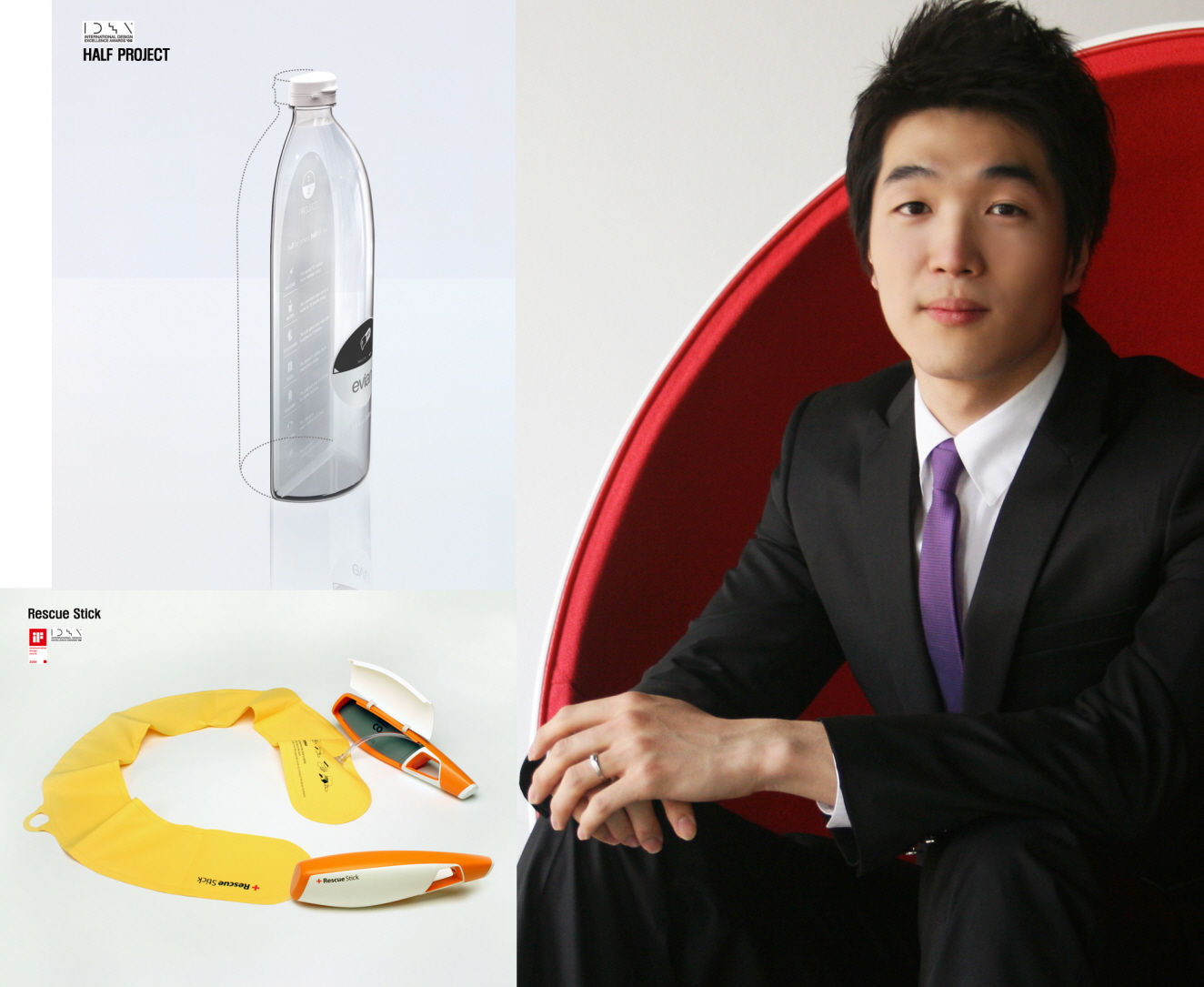 KAIST Senior Wins Prizes at International Design Contests
Sung-Joon Kim, a senior at the Department of Industrial Design, KAIST, has recently won the highest prize at the iF Communication Design Award held in Hanover, Germany, university officials said on Monday (June 3).
The prizewinning work entitled "1/2 PROJECT" introduces a donation system in which a customer buys a bottle of drink, for example, containing only a half of its price value and donate the remaining half of the value. The work which was created as part of the Samsung Design Membership was also awarded a silver prize at the International Design Excellence Awards (IDEA) of the United States.
Award ceremonies of the two prizes are scheduled for in Muenchen in August and in Miami in September, respectively.
"The design project is aimed at making donation a part of everyday life by teaming up with big-name beverage makers," said Kim.
iF Communication Design Award and the IDEA are among the world"s three leading international design competitions. The other one is the Red Dot Design Award presented in Essen, Germany.
Early this year, Kim, leading a team, presented a portable life saving equipment called "Rescue Stick" to the two competitions and won high honors.
2009.06.05 View 16386
KAIST Senior Wins Prizes at International Design Contests
Sung-Joon Kim, a senior at the Department of Industrial Design, KAIST, has recently won the highest prize at the iF Communication Design Award held in Hanover, Germany, university officials said on Monday (June 3).
The prizewinning work entitled "1/2 PROJECT" introduces a donation system in which a customer buys a bottle of drink, for example, containing only a half of its price value and donate the remaining half of the value. The work which was created as part of the Samsung Design Membership was also awarded a silver prize at the International Design Excellence Awards (IDEA) of the United States.
Award ceremonies of the two prizes are scheduled for in Muenchen in August and in Miami in September, respectively.
"The design project is aimed at making donation a part of everyday life by teaming up with big-name beverage makers," said Kim.
iF Communication Design Award and the IDEA are among the world"s three leading international design competitions. The other one is the Red Dot Design Award presented in Essen, Germany.
Early this year, Kim, leading a team, presented a portable life saving equipment called "Rescue Stick" to the two competitions and won high honors.
2009.06.05 View 16386 -
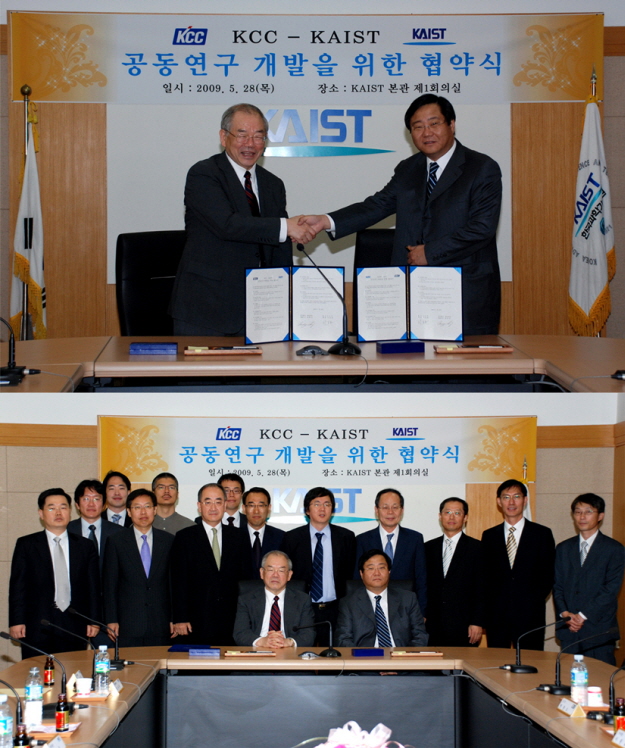 KAIST Signs Agreement for Industry-Academia Cooperation with KCC
KAIST signed an agreement for industry-academia cooperation with KCC, Korea"s leading supplier of building & industrial materials, on May 28, university sources said.
The agreement signed by KAIST President Nam-Pyo Suh and Mong-Jin Chung, Chairman of the KCC Business Group, calls for KAIST and KCC to conduct joint research for the development of new technologies in nano science, new materials areas and interdisciplinary areas.
Under the agreement, KCC will invest 5 billion won into the KAIST Institute for the NanoCentury over the next five years.
KCC Chairman Chung said: "Through this industry-academia cooperation agreement, we are seeking to give part of our profits back to community . We hope this agreement to contribute to the development of core technologies of the future in the new materials field, and nurturing specialized manpower."
2009.05.28 View 15318
KAIST Signs Agreement for Industry-Academia Cooperation with KCC
KAIST signed an agreement for industry-academia cooperation with KCC, Korea"s leading supplier of building & industrial materials, on May 28, university sources said.
The agreement signed by KAIST President Nam-Pyo Suh and Mong-Jin Chung, Chairman of the KCC Business Group, calls for KAIST and KCC to conduct joint research for the development of new technologies in nano science, new materials areas and interdisciplinary areas.
Under the agreement, KCC will invest 5 billion won into the KAIST Institute for the NanoCentury over the next five years.
KCC Chairman Chung said: "Through this industry-academia cooperation agreement, we are seeking to give part of our profits back to community . We hope this agreement to contribute to the development of core technologies of the future in the new materials field, and nurturing specialized manpower."
2009.05.28 View 15318 -
 Five Prominent Figures Appointed as KAIST Admission Officers
KAIST appointed five celebrated figures including Seung Park, former Bank of Korea governor, as admission officers on May 15, university authorities said on Thursday (May 14).
The four others are Moon-Soul Chung, founder and former CEO of Mirae Corp., who is well known as the first-generation venture entrepreneur in Korea; In-ho Lee, former Korean ambassador to Russia; Myung-ja Kim, former minister of environment; and former KAIST President Chang-sun Hong who was a National Assemblyman.
Their appointment is designed to guarantee transparency and fairness in a new undergraduate admission system. KAIST has decided to select. 150 freshmen from among 1,000 students recommended by the principals of as many general high schools across the country. The five special admission officers will participate in interviewing the recommended students. The new screening system which is introduced to broaden the field of applicants to graduates from schools other than science high schools will be implemented from the next school year.
The newly appointed admission officers will have orientation sessions on May 28-29 and then visit high schools nationwide to interview the recommended students in June and July.
KAIST set off a new trend in the admission process when President Nam-Pyo Suh announced in March that 150 students, or about 16 percent of the freshmen enrollment, would be recruited from regular high schools solely on the basis of their principals" recommendation and interview results in March.
Award-winning records at math or science competitions will not be put into account in admissions to prevent after-school tutoring aimed at winning such contests. Unveiling the new admission plan, President Suh said, "We expect the principals to recommend students with special talents or potential rather than high grades."
Established under a special law in 1971, KAIST is given full liberty to recruit freshmen students in whatever method it deems right, without being required to use the scholastic ability test scores of applicants as the basic criteria.
The socially respected admission officers will single out 300 from among the 1,000 recommended students for further review. Out of the 300, the final 150 students will be chosen through in-depth interviews by KAIST professors.
"Through years of receiving principal"s recommendations and judging the academic records of the recommended students at KAIST, we can accumulate a database on high schools nationwide. If a student from a certain high school turns out to be no good, we might not pick any more student from that school," Suh said.
Over 80 percent of students admitted to KAIST this year were graduates of elite institutions, mostly science high schools. Only 20 percent came from regular high schools. Ten percent of the 150 additional openings for regular high school graduates will be alloted to students from rural areas and another 10 percent to low-income households.
"A certain high school was not able to send even a single student to KAIST for the last 10 years. I"m sure there are talented students in that school. If we give the school a chance, it wil help improve the education environment in this country," Suh said.
2009.05.22 View 13871
Five Prominent Figures Appointed as KAIST Admission Officers
KAIST appointed five celebrated figures including Seung Park, former Bank of Korea governor, as admission officers on May 15, university authorities said on Thursday (May 14).
The four others are Moon-Soul Chung, founder and former CEO of Mirae Corp., who is well known as the first-generation venture entrepreneur in Korea; In-ho Lee, former Korean ambassador to Russia; Myung-ja Kim, former minister of environment; and former KAIST President Chang-sun Hong who was a National Assemblyman.
Their appointment is designed to guarantee transparency and fairness in a new undergraduate admission system. KAIST has decided to select. 150 freshmen from among 1,000 students recommended by the principals of as many general high schools across the country. The five special admission officers will participate in interviewing the recommended students. The new screening system which is introduced to broaden the field of applicants to graduates from schools other than science high schools will be implemented from the next school year.
The newly appointed admission officers will have orientation sessions on May 28-29 and then visit high schools nationwide to interview the recommended students in June and July.
KAIST set off a new trend in the admission process when President Nam-Pyo Suh announced in March that 150 students, or about 16 percent of the freshmen enrollment, would be recruited from regular high schools solely on the basis of their principals" recommendation and interview results in March.
Award-winning records at math or science competitions will not be put into account in admissions to prevent after-school tutoring aimed at winning such contests. Unveiling the new admission plan, President Suh said, "We expect the principals to recommend students with special talents or potential rather than high grades."
Established under a special law in 1971, KAIST is given full liberty to recruit freshmen students in whatever method it deems right, without being required to use the scholastic ability test scores of applicants as the basic criteria.
The socially respected admission officers will single out 300 from among the 1,000 recommended students for further review. Out of the 300, the final 150 students will be chosen through in-depth interviews by KAIST professors.
"Through years of receiving principal"s recommendations and judging the academic records of the recommended students at KAIST, we can accumulate a database on high schools nationwide. If a student from a certain high school turns out to be no good, we might not pick any more student from that school," Suh said.
Over 80 percent of students admitted to KAIST this year were graduates of elite institutions, mostly science high schools. Only 20 percent came from regular high schools. Ten percent of the 150 additional openings for regular high school graduates will be alloted to students from rural areas and another 10 percent to low-income households.
"A certain high school was not able to send even a single student to KAIST for the last 10 years. I"m sure there are talented students in that school. If we give the school a chance, it wil help improve the education environment in this country," Suh said.
2009.05.22 View 13871 -
 International News Outlets Report on KAIST's On-Line Electric Vehicle Project
International news agencies such as the Associated Press and Reuters have recently reported on the "online" electric vehicle project KAIST is proceeding with. A number of newspapers abroad including the New York Times and the South China Morning Post of Hong Kong published the articles. Following are excerpts from those reports.
-------------------
S. Koreans designing "online" electric vehicles
By JEAN H. LEE
Associated Press
Urban visionaries in London and Seoul, two of the world"s busiest capital cities, foresee buses gliding through their streets with speed, ease and efficiency _ without emitting the exhaust fumes that scientists say are contributing to global warming.Under Mayor Boris Johnson"s vision, London"s iconic red double-decker Routemaster buses would be back on the streets _ but powered by electricity, not gasoline.
Engineers at South Korea"s top-ranked KAIST university are meanwhile working on a novel prototype for an electric vehicle system: one that provides power on the go through induction strips laid into the roadway.
Cities _ which house 75 percent of the world"s population and generate 80 percent of its pollution _ must take leadership in tackling the problem of polluting emissions, Johnson said Monday in Seoul on the eve of the third C40 Large Cities Climate Summit.
"I think as a collective of cities, what we should be doing here in Seoul is agreeing that we are going to stop the endless addiction of mankind to the internal combustion engine," he told reporters. "It"s time that we moved away from fossil fuels. It"s time that we went for low-carbon vehicles."
"Cars form many problems that we see in Korea as well as other countries. We use hydrocarbon organic fuels, mostly petroleum, and that, in turn, creates environmental problems _ and Seoul is notorious," said Suh Nam-pyo, president of KAIST in Daejeon, south of the South Korean capital.
Seoul, population 10 million, is getting warmer three times faster than the world average, the National Meteorological Administration said Monday.
The obvious solution, Suh said, is to "replace all these vehicles with vehicles that do not pollute the air and do not use oil."
Back in March, Johnson zipped down a British highway in a U.S.-made electric car that he wrote marked "the beginning of a long-overdue revolution."
He rhapsodized in a Telegraph newspaper editorial that the Tesla has no exhaust pipe, carburetor or fuel tank, and "while every other car on that motorway was a-parping and a-puttering, filling the air with fumes and particulates, this car was producing no more noxious vapours than a dandelion in an alpine meadow."
Last month, he launched an ambitious plan to get 100,000 electric cars onto the streets of London by 2015. He pushed for the creation of 25,000 charging stations and vowed to convert some 1,000 city vehicles to make London the "electric car capital of Europe."
"The age of the diesel-emitting bus has got to be over in London," Johnson said.
And scientists are still grappling with the massive, sensitive, costly and fast-depleting batteries that take the place of international combustion engines and gasoline. Electric cars run between 40 and 120 miles (60 to 200 kilometers) on one charge, and it takes anywhere from two to seven hours to fully recharge, said Christian Mueller of the IHS Global Insight consulting firm.
"Everybody is frantically working on coming up with a viable electric car," he said from Frankfurt, Germany.
Batteries "aren"t yet at a state where we can say they are cheap, they"re reliable and they"re easy to come by. They all still have their technical drawbacks," said Mueller, who specializes in electrics and electronics.
Suh, an MIT-trained inventor with some 60 international patents to his name, approached the challenge from another angle.
"Why not have power transmitted on the ground and pick it up without using mechanical contact?" he said in an interview in his office overlooking the staging grounds for the university"s electric cars.
KAIST"s "online" vehicles pick up power from trips, or inverters, embedded into the road rather than transmitted through rails or overhead wires. A small battery, one-fifth the size of the bulky batteries typically used, would give the vehicle enough power for another 50 miles (80 kilometers), said Cho Dong-ho, the scientist in charge of the project.
South Korea produces its own nuclear power, meaning it can produce a continuous supply of energy to fuel such a plan.
President Lee Myung-bak, whose government gave KAIST $50 million for two major projects, including the "online" electric vehicle, took a spin in February.
Online buses are running at the KAIST campus and will begin test runs soon on the resort island of Jeju.
But Seoul, which has promised to set aside $2 million for the underground charging system, is within Suh"s sights. He said 9,000 gasoline-fueled buses now crisscross the capital, with 1,000 going out of commission each year. He envisions replacing those aging buses with electric models. Initial test runs are expected to take place this year.
Mueller, the consultant, called it a creative approach with potential.
"It sounds very intriguing; you don"t store your energy, you provide it on the go." he said. "The (battery) storage problem is overcome instantly. That would be a very intriguing way of doing it."
-----------------------------
South Korea tries recharging road to power vehicles
By Jon Herskovitz
SEOUL (Reuters) - South Korea"s top technology university has developed a plan to power electric cars through recharging strips embedded in roadways that use a technology to transfer energy found in some electric toothbrushes.
The plan, still in the experimental stage, calls for placing power strips about 20 cm (8 inches) to 90 cm (35 inches) wide and perhaps several hundred meters long built into the top of roads.
Vehicles with sensor-driven magnetic devices on their underside can suck up energy as they travel over the strips without coming into direct contact.
"If we place these strips on about 10 percent of roadways in a city, we could power electric vehicles," said Cho Dong-ho, the manager of the "online electric vehicle" plan at the Korea Advanced Institute of Science and Technology.
The university has built a prototype at its campus in Daejeon, about 140 km (90 miles) south of Seoul, for electric-powered golf carts and is working on designs that would power cars and buses.
The system that can charge several vehicles at once would allow electric cars and buses to cut down on their battery sizes or extend their ranges.
The non-contact transfer of electricity, also called inductive charging, works by magnets and cables on the underside of the vehicle making a connection with the current in the recharging strip to receive power as they travel over it.
It is employed in some brands of electric toothbrushes that are sealed and water resistant, which do not need to be plugged into anything but use a magnetic connection to receive energy while resting in a cradle.
The recharging strips, which are attached to small electrical stations, would be laid in places such as bus lanes and the roads running up to intersections so that vehicles could power up where traffic slows down, Cho said.
The system will be tested later this year for use in the bus systems of Seoul and other South Korea cities while some of the country"s automakers are also cooperating in the project.
Unlike electric lines used for trams, vehicles do not need to be in constant contact with the strips and a person can touch the lines without receiving a shock.
The system so far has proven safe to humans and machinery, Cho said.
The cost of installing the system is an estimated 400 million won ($318,000) per kilometer of road. Electricity is extra.
2009.05.21 View 17532
International News Outlets Report on KAIST's On-Line Electric Vehicle Project
International news agencies such as the Associated Press and Reuters have recently reported on the "online" electric vehicle project KAIST is proceeding with. A number of newspapers abroad including the New York Times and the South China Morning Post of Hong Kong published the articles. Following are excerpts from those reports.
-------------------
S. Koreans designing "online" electric vehicles
By JEAN H. LEE
Associated Press
Urban visionaries in London and Seoul, two of the world"s busiest capital cities, foresee buses gliding through their streets with speed, ease and efficiency _ without emitting the exhaust fumes that scientists say are contributing to global warming.Under Mayor Boris Johnson"s vision, London"s iconic red double-decker Routemaster buses would be back on the streets _ but powered by electricity, not gasoline.
Engineers at South Korea"s top-ranked KAIST university are meanwhile working on a novel prototype for an electric vehicle system: one that provides power on the go through induction strips laid into the roadway.
Cities _ which house 75 percent of the world"s population and generate 80 percent of its pollution _ must take leadership in tackling the problem of polluting emissions, Johnson said Monday in Seoul on the eve of the third C40 Large Cities Climate Summit.
"I think as a collective of cities, what we should be doing here in Seoul is agreeing that we are going to stop the endless addiction of mankind to the internal combustion engine," he told reporters. "It"s time that we moved away from fossil fuels. It"s time that we went for low-carbon vehicles."
"Cars form many problems that we see in Korea as well as other countries. We use hydrocarbon organic fuels, mostly petroleum, and that, in turn, creates environmental problems _ and Seoul is notorious," said Suh Nam-pyo, president of KAIST in Daejeon, south of the South Korean capital.
Seoul, population 10 million, is getting warmer three times faster than the world average, the National Meteorological Administration said Monday.
The obvious solution, Suh said, is to "replace all these vehicles with vehicles that do not pollute the air and do not use oil."
Back in March, Johnson zipped down a British highway in a U.S.-made electric car that he wrote marked "the beginning of a long-overdue revolution."
He rhapsodized in a Telegraph newspaper editorial that the Tesla has no exhaust pipe, carburetor or fuel tank, and "while every other car on that motorway was a-parping and a-puttering, filling the air with fumes and particulates, this car was producing no more noxious vapours than a dandelion in an alpine meadow."
Last month, he launched an ambitious plan to get 100,000 electric cars onto the streets of London by 2015. He pushed for the creation of 25,000 charging stations and vowed to convert some 1,000 city vehicles to make London the "electric car capital of Europe."
"The age of the diesel-emitting bus has got to be over in London," Johnson said.
And scientists are still grappling with the massive, sensitive, costly and fast-depleting batteries that take the place of international combustion engines and gasoline. Electric cars run between 40 and 120 miles (60 to 200 kilometers) on one charge, and it takes anywhere from two to seven hours to fully recharge, said Christian Mueller of the IHS Global Insight consulting firm.
"Everybody is frantically working on coming up with a viable electric car," he said from Frankfurt, Germany.
Batteries "aren"t yet at a state where we can say they are cheap, they"re reliable and they"re easy to come by. They all still have their technical drawbacks," said Mueller, who specializes in electrics and electronics.
Suh, an MIT-trained inventor with some 60 international patents to his name, approached the challenge from another angle.
"Why not have power transmitted on the ground and pick it up without using mechanical contact?" he said in an interview in his office overlooking the staging grounds for the university"s electric cars.
KAIST"s "online" vehicles pick up power from trips, or inverters, embedded into the road rather than transmitted through rails or overhead wires. A small battery, one-fifth the size of the bulky batteries typically used, would give the vehicle enough power for another 50 miles (80 kilometers), said Cho Dong-ho, the scientist in charge of the project.
South Korea produces its own nuclear power, meaning it can produce a continuous supply of energy to fuel such a plan.
President Lee Myung-bak, whose government gave KAIST $50 million for two major projects, including the "online" electric vehicle, took a spin in February.
Online buses are running at the KAIST campus and will begin test runs soon on the resort island of Jeju.
But Seoul, which has promised to set aside $2 million for the underground charging system, is within Suh"s sights. He said 9,000 gasoline-fueled buses now crisscross the capital, with 1,000 going out of commission each year. He envisions replacing those aging buses with electric models. Initial test runs are expected to take place this year.
Mueller, the consultant, called it a creative approach with potential.
"It sounds very intriguing; you don"t store your energy, you provide it on the go." he said. "The (battery) storage problem is overcome instantly. That would be a very intriguing way of doing it."
-----------------------------
South Korea tries recharging road to power vehicles
By Jon Herskovitz
SEOUL (Reuters) - South Korea"s top technology university has developed a plan to power electric cars through recharging strips embedded in roadways that use a technology to transfer energy found in some electric toothbrushes.
The plan, still in the experimental stage, calls for placing power strips about 20 cm (8 inches) to 90 cm (35 inches) wide and perhaps several hundred meters long built into the top of roads.
Vehicles with sensor-driven magnetic devices on their underside can suck up energy as they travel over the strips without coming into direct contact.
"If we place these strips on about 10 percent of roadways in a city, we could power electric vehicles," said Cho Dong-ho, the manager of the "online electric vehicle" plan at the Korea Advanced Institute of Science and Technology.
The university has built a prototype at its campus in Daejeon, about 140 km (90 miles) south of Seoul, for electric-powered golf carts and is working on designs that would power cars and buses.
The system that can charge several vehicles at once would allow electric cars and buses to cut down on their battery sizes or extend their ranges.
The non-contact transfer of electricity, also called inductive charging, works by magnets and cables on the underside of the vehicle making a connection with the current in the recharging strip to receive power as they travel over it.
It is employed in some brands of electric toothbrushes that are sealed and water resistant, which do not need to be plugged into anything but use a magnetic connection to receive energy while resting in a cradle.
The recharging strips, which are attached to small electrical stations, would be laid in places such as bus lanes and the roads running up to intersections so that vehicles could power up where traffic slows down, Cho said.
The system will be tested later this year for use in the bus systems of Seoul and other South Korea cities while some of the country"s automakers are also cooperating in the project.
Unlike electric lines used for trams, vehicles do not need to be in constant contact with the strips and a person can touch the lines without receiving a shock.
The system so far has proven safe to humans and machinery, Cho said.
The cost of installing the system is an estimated 400 million won ($318,000) per kilometer of road. Electricity is extra.
2009.05.21 View 17532